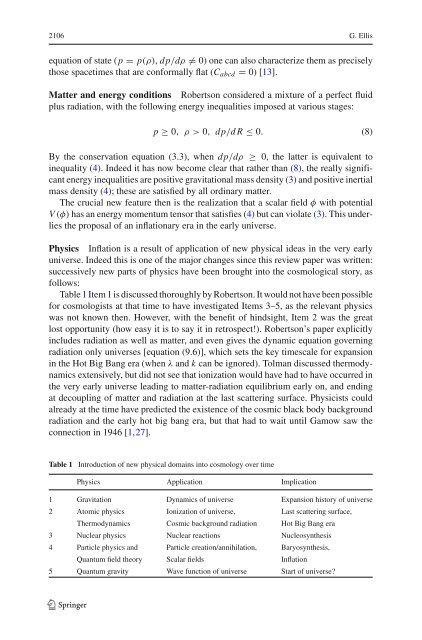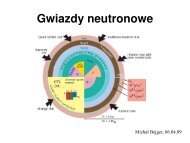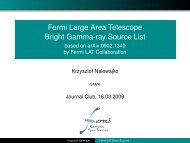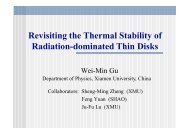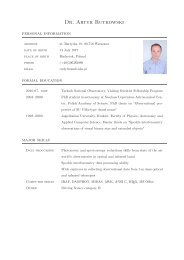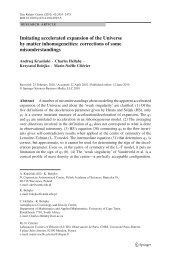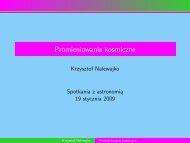Editorial note to: HP Robertson, Relativistic cosmology - Users' Pages
Editorial note to: HP Robertson, Relativistic cosmology - Users' Pages
Editorial note to: HP Robertson, Relativistic cosmology - Users' Pages
You also want an ePaper? Increase the reach of your titles
YUMPU automatically turns print PDFs into web optimized ePapers that Google loves.
2106 G. Ellisequation of state (p = p(ρ), dp/dρ ̸= 0) one can also characterize them as preciselythose spacetimes that are conformally flat (C abcd = 0) [13].Matter and energy conditions <strong>Robertson</strong> considered a mixture of a perfect fluidplus radiation, with the following energy inequalities imposed at various stages:p ≥ 0, ρ > 0, dp/dR ≤ 0. (8)By the conservation equation (3.3), when dp/dρ ≥ 0, the latter is equivalent <strong>to</strong>inequality (4). Indeed it has now become clear that rather than (8), the really significantenergy inequalities are positive gravitational mass density (3) and positive inertialmass density (4); these are satisfied by all ordinary matter.The crucial new feature then is the realization that a scalar field φ with potentialV (φ) has an energy momentum tensor that satisfies (4) but can violate (3). This underliesthe proposal of an inflationary era in the early universe.Physics Inflation is a result of application of new physical ideas in the very earlyuniverse. Indeed this is one of the major changes since this review paper was written:successively new parts of physics have been brought in<strong>to</strong> the cosmological s<strong>to</strong>ry, asfollows:Table 1 Item 1 is discussed thoroughly by <strong>Robertson</strong>. It would not have been possiblefor cosmologists at that time <strong>to</strong> have investigated Items 3–5, as the relevant physicswas not known then. However, with the benefit of hindsight, Item 2 was the greatlost opportunity (how easy it is <strong>to</strong> say it in retrospect!). <strong>Robertson</strong>’s paper explicitlyincludes radiation as well as matter, and even gives the dynamic equation governingradiation only universes [equation (9.6)], which sets the key timescale for expansionin the Hot Big Bang era (when λ and k can be ignored). Tolman discussed thermodynamicsextensively, but did not see that ionization would have had <strong>to</strong> have occurred inthe very early universe leading <strong>to</strong> matter-radiation equilibrium early on, and endingat decoupling of matter and radiation at the last scattering surface. Physicists couldalready at the time have predicted the existence of the cosmic black body backgroundradiation and the early hot big bang era, but that had <strong>to</strong> wait until Gamow saw theconnection in 1946 [1,27].Table 1 Introduction of new physical domains in<strong>to</strong> <strong>cosmology</strong> over timePhysics Application Implication1 Gravitation Dynamics of universe Expansion his<strong>to</strong>ry of universe2 A<strong>to</strong>mic physics Ionization of universe, Last scattering surface,Thermodynamics Cosmic background radiation Hot Big Bang era3 Nuclear physics Nuclear reactions Nucleosynthesis4 Particle physics and Particle creation/annihilation, Baryosynthesis,Quantum field theory Scalar fields Inflation5 Quantum gravity Wave function of universe Start of universe?123


